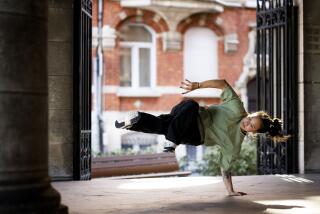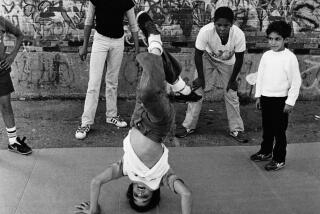Coiled and Ready
- Share via
David Wallace, like many a novice, is rushing his moves.
“Bend your knees, use your whole body. Don’t get ahead of yourself,” advises his teacher, Robert Dante, a ruddy-faced Englishman-turned-Texan-turned-Californian with curly white hair and penetrating blue eyes.
To anyone who’s ever taken a tennis l or golf lesson, Dante’s words ring painfully familiar. Here, though, is where the resemblance to any run-of-the-mill sports lesson ends. Instead of a tennis racket, Wallace holds in his right hand a 5-foot-long whip made of braided kangaroo hide. The uniform for the sport of whip cracking, judging by this teacher and student, is a black cowboy hat with a black or white button-down shirt, black jeans and a Lone Star belt buckle. The playing field is a weedy backyard in North Hollywood on a searing late-July afternoon.
The student practices his basic strokes--the overhand, which is like throwing a baseball; the circus crack, a chopping motion like wielding a meat cleaver; and the reverse snap, which is the circus crack at a 45-degree angle across the body.
He swings awkwardly, and the whip hesitates, failing to pick up altitude and knocking against the brim of his hat. “I’m glad you’re wearing a hat,” Dante comments wryly. Hats have protected more than one aspiring whip cracker.
When a whip is successfully cracked, it travels at the speed of sound. The whip does not require contact with any surface--hard, fleshy or otherwise to create that distinctive sound, which is as sharp and deafening as any gunshot as it breaks the sound barrier. In traditional herding cultures, the whip is prized for this noisemaking capacity, as animals scamper away from the frightening noise and into the pen, rather than for its ability to inflict physical pain.
In Dante’s hands, the whip is a serpent, undulating lazily just above the ground. It is a stylus, tracing graceful figure-eights in the air. It is a knife, slicing a playing card in half or snatching a leaf from a tree. It is a musical instrument, cracking rapidly three times, pausing, then cracking once more, like the rat-a-tat of some gigantic drum. It is a lover’s hand, gently caressing an outstretched wrist as it drifts earthward.
A lesson in the art of the whip is a lesson in mental focus, in efficiency of motion, in channeling a smooth flow of energy from torso to hand to whip. Those who have a background in a deliberate, inward-focused martial art such as tai chi have the easiest time learning the whip, Dante says.
Even novices who are still trying not to hit themselves upside the head can begin to appreciate the whip’s spiritual dimension. “There’s a life force in this whip, common to the life force of the creature it came from, extending from me, through this creature, into the world. There’s a spiritual focus,” says Wallace, a mechanic for the L.A. Unified School District, who prefers to be known by the single name Faol, or “wolf” in Gaelic.
A lesson in the whip is also a lesson in physics. Dante swings his arm seemingly without effort and at no great speed. The whip’s tapered design sends it looping at ever-increasing speeds so that a simple downward stroke of the human arm becomes a sonic boom by the time the whip coils at its tip.
For some, the whip is also a tool to test the boundaries of sensory experience. Along with leather collars and handcuffs, whips are part of the sadomasochist’s arsenal. In addition to his more traditional whip-cracking lessons, Dante gives workshops at S&M; clubs around the country. Dante says only a small percentage use the whip to inflict pain; for most, the possibility of pain is titillation enough, he says.
Whip enthusiasts caution against automatically associating the whip with the darker side of human sexuality. “People assume that the whip means kink. It’s not true. The whip is a sport, a dance,” says Rob Monroe, an actor and member of the L.A. Whip Enthusiasts, a club that meets once a month and has a mailing list of about 60 members.
The whip has been used by herders since time immemorial. Australian stockmen on horseback still use 7-foot whips to herd cattle or sheep, never making contact with the animals but using the sound of the whip to direct them. Sled-dog drivers use the whip to urge their animals on. In Australia, whip cracking is a competitive sport. At the Australian national championships, competitors perform routines and are required to demonstrate accuracy by slicing foam cups in half.
In the heyday of the western movie, actors Lash LaRue and Whip Wilson used whips to disarm opponents. More recently, whips have been wielded by Harrison Ford as Indiana Jones, Anthony Hopkins in “The Mask of Zorro,” and Michelle Pfeiffer as Catwoman in “Batman Returns.”
“The whip says a great deal about the character, that she has multiple layers, that she’s playful, highly skilled, very dangerous,” says Anthony De Longis, who trained Pfeiffer on the whip for the Catwoman role.
Back in North Hollywood, Wallace, nearing the end of an hourlong lesson, is wreaking havoc on the backyard vegetation. Finally, a jacaranda pod falls victim to his whip. He’s not quite ready to slice a playing card, but it’s a start.



